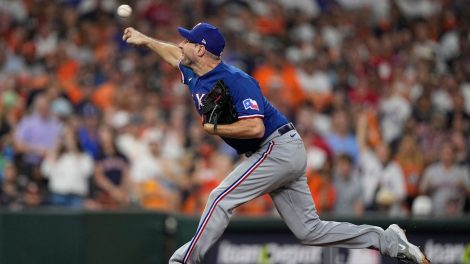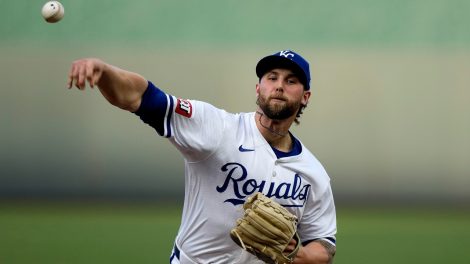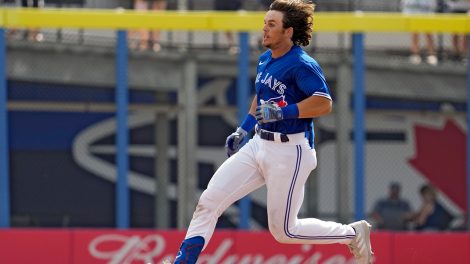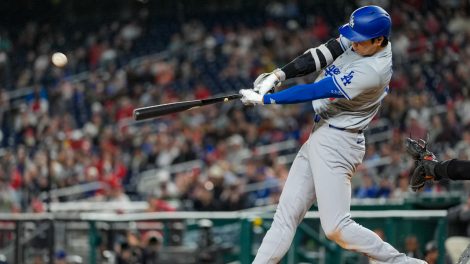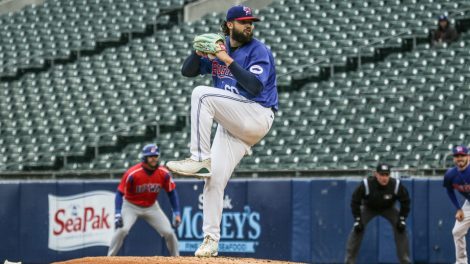TORONTO – A recurring thought as the four division series played out – Ken Giles sure could have made a big difference for a lot of these teams.
Might the ousted Atlanta Braves and Los Angeles Dodgers still be playing had they acquired the Toronto Blue Jays closer before the July 31 trade deadline? How improved would the Washington Nationals’ chances be in the National League Championship Series if they had managed to get Giles at the same time they picked up Daniel Hudson?
All three clubs, along with the New York Yankees (who nixed a deal with the Blue Jays right at the finish line), Minnesota Twins (for whom Giles wouldn’t have made a difference) and Cleveland Indians (who missed out on a wild card), to varying degrees pursued the 29-year-old, who is eligible for free agency after next season.
An elbow issue at the time complicated matters for the Blue Jays, who discussed and considered trades with returns contingent upon Giles’ health. Ultimately, once the talks with the Yankees fell apart, they decided their best bet was holding on to him and trying again in the winter, or perhaps, the 2020 trade deadline.
In doing so, finding how to best leverage the asset becomes one of their most important tasks of the off-season. The latest demonstration of how pivotal a shutdown bullpen can be in the playoffs may help the Blue Jays’ cause if they are determined to trade him. At the same time, it underlines the importance of having reliable relief arms to lock down games, and while the pressures of October aren’t likely to be an issue for them next year, the morale of a young team hoping to progress matters plenty.
[snippet id=3305549]
“We’ll weigh what it means to have him, versus what it means to trade him for some other value,” is how general manager Ross Atkins put it during his season wrap availability earlier this month. “He has a significant contribution so we would have to factor in that subtraction if we were to trade him. Thinking about it from a strategy standpoint, he’s been exceptional, he had an incredible year so it’s not someone we’d have to say we’re open to trading him. I’m sure there will be significant interest in him. And that varies from off-season to in-season. Typically, relievers are more valuable at the deadline.”
That may be true, but such an approach is probably the riskiest of the four options the Blue Jays really have right now:
• Trade Giles during the off-season;
• Hold on to Giles this winter and try to deal him ahead of the 2020 deadline;
• Keep Giles throughout next season, extend him a qualifying offer and take the compensatory draft pick once he walks;
• Keep Giles and sign him to a contract extension.
Keep and qualify
Let’s start with option No. 3, keeping Giles for 2020 and then extending him the qualifying offer, because it’s the easiest to eliminate.
There’s merit to keeping him next season, especially considering the step forward in leadership he showed this past year. Understanding there was an experience void in the Blue Jays clubhouse, he took on a more active role, helping structure post-game celebrations with Luke Maile and awarding championship belts to a player of the game after wins.
He hadn’t done such things in the past even though, “I knew I had the traits,” he said.
“But I didn’t know if I spoke up, if I’d be out of line a little bit, just being around a lot of veterans back in the day. I didn’t know if it was correct or not,” Giles continued. “This year, I went with the flow and whatever came to mind, I spoke up about it and it’s benefitted me.”
Frittering away wins in the ninth inning sucks and the Blue Jays must be wary of opening up their young roster to nervous finishes. Still, to keep the asset alive beyond 2020, they’d either have to sign an extension in advance or extend Giles a qualifying offer, which will probably be around $20 million next fall.
Given the drag qualifying offers have created on free agents in recent years, Giles’ acceptance is a real possibility, and the Blue Jays can’t risk paying him that for one season. Compounding things, next off-season is when the Blue Jays expect to start becoming more aggressive in free agency, which makes $20 million for one season on a closer particularly ludicrous.
So, not happening.
Keep and extend
If the Blue Jays are determined to keep him, then option No. 4 – signing Giles to an extension – makes the most sense, although there’s risk here, too.
Since coming over as part of the return from the Houston Astros for Roberto Osuna, Giles has made clear to everyone how much he’s liked Toronto. He’s formed a tight bond with pitching coach Pete Walker. He’s been able to rebound on the field after some well-documented struggles in Houston. It’s worked out so well for him that he hoped to not be traded before this year’s deadline.
“I was just enjoying myself, honestly,” Giles said. “Not that I didn’t want to be traded or go to a contender, but once you feel comfortable somewhere, you really don’t want to go anywhere. For one, this place makes my family happy and when my family’s happy, I’m happy. Winning is always a great thing in life, but it’s not always everything. I want to enjoy myself.”
The Blue Jays don’t have an obvious internal candidate for closer coming through the system, even with a bevy of power arms like Canadian Jordan Romano, Justin Shafer and Jason Adam knocking on the door. Sean Reid-Foley is an interesting possibility, but for now the Blue Jays seem intent on exhausting his chances as a starter.
[snippet id=4722869]
Signing Giles for, say, two years beyond 2020, when he’s projected to earn $8.4 million in his final year of arbitration by MLB Trade Rumors, makes sense for a team with aspirations of really competing in 2021.
On the flip side, there’s potential for volatility in Giles’ performance, especially given his past in Philadelphia and Houston. The elbow issues in 2019 are a concern for a pitcher as reliant on fastball velocity as he is, but he’s been remarkably durable, hitting the injured list for the first time in his career. “I’ve never been in that situation before,” he said. “It might happen more in my career but at least now I know what to expect. Not feeling 100 per cent all season, I made my adjustments, went with my gut feelings most of the time and I stuck with what I came up with.”
Still, every financial commitment the Blue Jays make now is one they’re not making in the future, so is he someone they want to tie up money in?
To this point, according to Giles, “we have not” had extension talks. “I’m pretty sure if that comes about, I’m more than willing to listen. If it’s not, it is what it is. I know the direction this organization is going and I’m not going to push something that’s not necessary.”
Uneasy off-season then?
“I’m going to go into it with the mentality of, ‘If I get moved, I get moved. If I don’t, I’ll see you guys next year and enjoy another great year,’” he replied.
If the Blue Jays are legitimately interested in keeping Giles longer-term, they could always bring him back next year, see how it goes and extend him in-season. There’s maximal flexibility taking that route, but typically, the closer a player gets to free agency, the harder it is to re-sign him.
The window for an extension is now.
Keep and trade in 2020
That makes option No. 2, keeping Giles and trading him ahead of the next deadline, an approach fraught with risk, one that despite what Atkins said about the value of relievers at the deadline, is far too dicey for the Blue Jays.
All you have to do is look at what happened with Josh Donaldson last year to understand why – the value on a player can drop sharply, or go to zero, almost instantly. In Giles’ case, another setback with his elbow, or a dip in his performance could make him untradeable, while also killing any desire to bring him back.
The Blue Jays narrowly avoided such a nightmare scenario with Aaron Sanchez but weren’t as lucky with Donaldson and, for different reasons, Osuna. There’s an adage in baseball that it’s better to trade a player too early than too late, and that may be very apt in this case.
Trade this winter
All of this leads us to option No. 1: trading Giles this off-season. If the Blue Jays don’t plan on extending him, this is really their only choice, and because of it, the return is unlikely to be the dream haul many might expect.
Properly reading the market here is essential, since the free-agent class isn’t particularly strong — even if Yankees closer Aroldis Chapman opts out of the final $30 million and two years left on his contract. Dellin Betances is intriguing and there are bounce-back candidates like Greg Holland and Cody Allen, but a one-year bet at around $10 million for Giles may be preferable to some teams, even with prospect capital in the acquisition cost.
Thanks to this summer’s talks, Atkins and the Blue Jays already have well defined starting points with a handful of interested clubs. Some of them may be spurned to act based on what happened to them in the post-season, while some could be motivated to avoid the fate of others. A deft touch will be needed to navigate through the leverage they have, and the pressure points working against them.
[relatedlinks]


